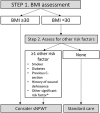Single-use negative pressure wound therapy to prevent surgical site complications in high-risk patients undergoing caesarean sections: a real-world study
- PMID: 37930777
- PMCID: PMC10627297
- DOI: 10.1093/intqhc/mzad089
Single-use negative pressure wound therapy to prevent surgical site complications in high-risk patients undergoing caesarean sections: a real-world study
Abstract
Surgical site complications (SSCs), including surgical site infection (SSI), are common following C-sections. Management of the post-operative incision with single-use negative pressure wound therapy (sNPWT) has been shown to reduce the risk of SSC in high-risk individuals. This study explored the outcomes of routine, real-world use of sNPWT in high-risk patients undergoing C-sections. An observational, retrospective in-service evaluation was conducted across eight obstetric centres in the Republic and Northern Ireland. Patients undergoing C-sections were stratified for their risk of developing SSC using commonly known risk factors, including BMI ≥30, smoking, diabetes, and whether the patients had undergone previous C-sections or had a previous history of wound dehiscence. Those at high-risk were treated with sNPWT post-operatively. Data relating to any SSC that developed post-operatively, for up to 30 days, were captured. Data were compared with original research previously published by Wloch et al. (2012). Of 1111 women considered high-risk, 106 (9.5%) went on to develop SSCs, predominantly superficial SSIs. SSCs were associated with extra visits with their general practitioner (GP), outpatient visits, or inpatient hospital stays in 5.7%, 2.4%, and 1.7% of the entire cohort, representing 59.4%, 25.5%, and 17.9% of the 106 patients with SSC. Patients needed on average 1.8 extra GP visits and 0.7 extra outpatient visits. Patients who needed to be readmitted to hospital had an average length of stay of 4 days. In comparison with a previously published cohort, in which sNPWT was not used, we observed a significant reduction in the incidence of SSCs across BMI groups 18.5-24.9 (P = 0.02), 25-29.9 (P = 0.003), and ≥35 kg/m2 (P = 0.04). In those patients who had undergone at least one previous C-section, the rates of complications also reduced (P = 0.006). This analysis provides further justification for using sNPWT to manage surgical incisions in patients considered at high risk of developing post-procedural SSCs, particularly those with a BMI ≥30 or a history of more than one C-section.
Keywords: caesarean section; negative pressure wound therapy; surgical site infection; wound-related complications.
© The Author(s) 2023. Published by Oxford University Press on behalf of International Society for Quality in Health Care.
Figures


References
-
- NICE . Caesarean Birth. NICE guideline. www.nice.org.uk/guidance/ng192 (1 February 2022, date last accessed).

